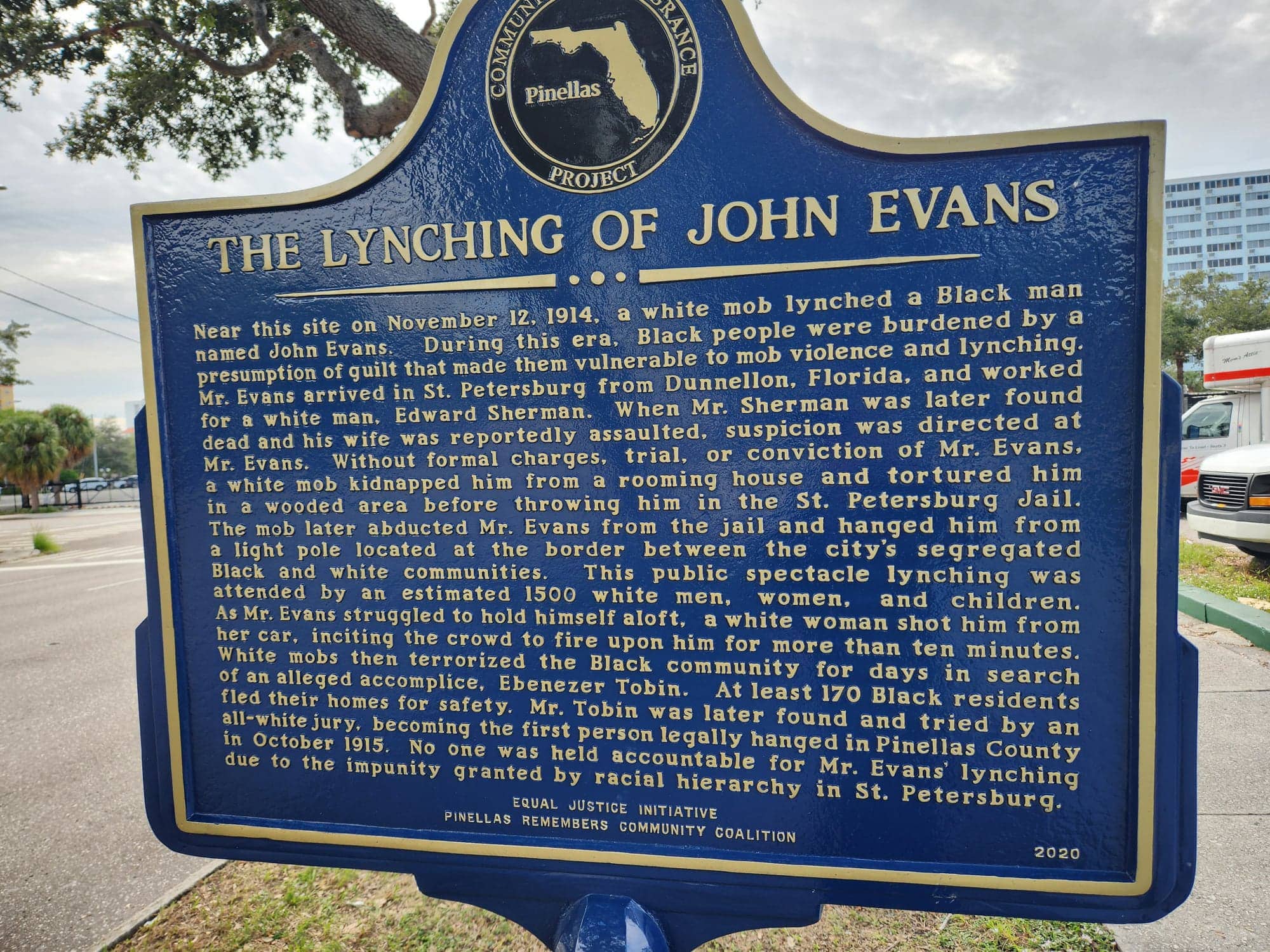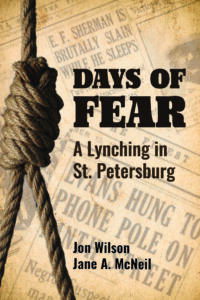Create
‘Days of Fear’ chronicles a bleak era in St. Petersburg history

On Nov. 12, 1914, John Evans – a Black man from the town of Dunnellon – was taken from the St. Petersburg jail by an angry white mob, hung by the neck from a lamppost on 9th Street South and riddled with bullets.
The lynching of John Evans remains the most shameful incident in local history. Sadly, in the Jim Crow South, such crimes were all too common after the turn of the 20th century.
 Veteran journalist Jon Wilson, in collaboration with Jane McNeil, looked deep into all available accounts to put together Days of Fear – A Lynching in St. Petersburg, as detailed a telling of this tragic story as we’re ever likely to get.
Veteran journalist Jon Wilson, in collaboration with Jane McNeil, looked deep into all available accounts to put together Days of Fear – A Lynching in St. Petersburg, as detailed a telling of this tragic story as we’re ever likely to get.
Evan had been accused of murdering St. Pete businessman Frank Sherman, and the sexual assault and beating of his wife, Mary. The Shermans were white, and the outrage among the white community – including what passed for law enforcement – was swift and terrible.
Evans, who denied his guilt, was never tried. Ebenezer Tobin, claimed by the prosecutors as Evans’ accomplice, was later tried, found guilty and hanged.
A longtime St. Petersburg Times reporter, Wilson first wrote about the lynching in the 1983 anthology Tampa Bay History. McNeil, a playwright and philanthropist, grew up on Snell Isle. Her grandfather was a local attorney at the time of Evans’ lynching. In the 1970s her mother, Jan Bangert, wrote a play called A Straw in the Wind, a fictionalized account of the incident.
“Jane,” reports Wilson, “is a bulldog for research. She lives in Philadelphia near Camden, the Shermans’ hometown. She discovered extensive human and archival resources that I believe I could not have found by myself. For example, she was able to flesh out Frank and Mary Sherman in ways I could not have done. She even discovered photos of them. All of it helped to humanize the tragic couple.”
Published by St. Petersburg Press, the 90-page Days of Fear is available at Tombolo Books, through Amazon and via the publisher.
St. Pete Catalyst: Forty years after you first wrote about these events, what if anything had changed? In other words, what could you bring to the table that you couldn’t in 1983?
Jon Wilson: The basic narrative of the murder and the subsequent lynching of John Evans and execution of Ebenezer Tobin did not change. In the 40-year interim, I became a better writer. I became a better editor, both of my own material and that of my co-author(s). I authored or co-authored several books about St. Petersburg history, and as co-author I did most of the actual writing. I also acquired a bit more patience in reading microfilm and collecting details about St Petersburg’s character in 1914.

Jon Wilson
Did this horrible, tragic, sad story haunt you all that time?
Wilson: Haunted would be too strong a description. But I did not write the 1983 piece and just forget about it. It frequently whispered to me. Sometimes I wondered about writing a novel based on the incident. Sometimes I’d see it referenced in someone else’s research. Sometimes I wondered who else might still be alive who remembered or even witnessed the lynching.
Fate and a mutual friend, the playwright Bill Leavengood, brought Jane McNeil and I together. I don’t even recall who actually suggested that we do a book. But it seemed right to do. It was clear that Jane had a calling to do more.
I imagine that your research, limited essentially to what had been printed at the time, could only take you so far. Can you talk about the research process, and what were the “eureka moments,” when you unearthed something important that you didn’t already know?
Wilson: My eureka moment came when I was doing the original research that resulted in the Tampa Bay History article. The first writing was actually for a term paper in Prof. Ray Arsenault’s class on race. I was poking along, looking at microfilm, interviewing a couple of old-timers, when I decided to snail-mail the Camden Courier [the Shermans’ New Jersey hometown newspaper] and ask what it had about the lynching and the murder and assault that led to it.
Somewhat to my surprise, one of the Courier’s news archivists snail-mailed me back with copies of some articles. One article said that the lawyer for the Shermans had said, and I’m paraphrasing, that a secret committee composed of 15 of St Petersburg’s wealthiest citizens had decided John Evans had to die. In addition, one of my interviewees said that earlier in the day of the lynching, a policeman had visited his family’s house near the eventual lynching site. The officer said the family should go stay somewhere else that evening because there was going to be trouble nearby.
Those two revelations stunned me, as I had been thinking the lynching had been the work of an inflamed mob acting on its own emotion. It changed my thinking about the entire episode, and to a degree, my view of St. Petersburg’s early history.

Jane McNeil
St. Pete Catalyst: What did you learn, researching these events, that you didn’t know before?
Jane McNeil: What I learned from years of reading old newspapers, books on local history and various other archives about my hometown and the lives of those individuals involved with the lynching was how much I had been ignorant of and blind to during my childhood. My parents on separate occasions had driven me through the Black community. I had seen the small, modest, and un-air conditioned bungalows that lined the streets, but I also saw Cadillacs in the driveways. Since my mother owned a Cadillac, I assumed as a child their lives were similar to mine.
My mother had two Black housekeepers; one for cleaning and one for ironing. Neither she nor they educated me about civil rights, Jim Crow laws, or the plight of the Black residents, who had undoubtedly been forbidden to live in our neighborhood. No one commented on the lack of students of color in my schools. I did not acknowledge that there were never Black children or adults in the parks downtown, at the yacht club or the country club, or walking the sidewalks where I often rode my bicycle. I did not learn about racism, bigotry or lynchings while in elementary or middle school. It seems unfathomable that I could somehow dismiss this part of my childhood, but then I didn’t have an ordinary childhood. My memories would only allow me to keep the positive ones and dismiss the painful. Therefore, I can only be fortunate that I did learn of my hometown’s history and that I was able to assist later in life in righting a wrong.
Why, in your mind, is it important today that we understand these people and their motivations? Is it as simple as “Those who don’t learn from history are doomed to repeat it”? Or is it more complex than that?
Wilson: I believe it is more complex. Heck, we learn from (or about) history and still repeat it. There are psychological elements in incidents like this that I am not qualified to assess or offer much speculation. But the lynching episode turned on fear, anger and hatred. Fear of Black people, fear of losing a prosperous tourist season, fear that St. Petersburg’s reputation would be ruined if it appeared that a murderer or murderers were running free. Such fears easily convert to anger. Get a few fearful and angry people, throw in a passionate leader and a few more people along for what they want to see as fun and you have a dangerous mob. Mobs bully. Like an individual bully does, they go after those perceived as weak or helpless. The maid Lula Grant expressed it well: “We was just Black people, that’s all, and they was white.”
I’m not optimistic we can stop mob violence altogether. But we can shine a light on it. We can show that the participants are irresponsible thugs. We can embarrass them. It’s not surprising that the events of 1914 were talked about in hushed tones, if at all, or were deliberately covered up.
McNeil: Today, I read, keep informed and actively give to associations for women, children and minorities. I cannot ignore when individuals are being hateful and speak out when confronted with a racist person or act. If language is being used in a derogatory manner, I will correct it. This was not what I imagined I would ever be called to do. However, Jon Wilson has not only become my friend, he is a mentor. From his active participation in St. Petersburg in supporting the Black community to tell their history and stories, I felt inspired to do the work and find the truth about what happened that fateful night in November of 1914. Hopefully, I have helped in some capacity clear the names of the two men that were wrongfully accused and killed for the murder I wholeheartedly believe they did not commit.







